Research on the Smart Broad Bean Harvesting System and the Self-Adaptive Control Method Based on CPS Technologies
Abstract
1. Introduction
2. Overall Framework
3. Key Technologies
3.1. Intelligent Perception Environment Configuration of the SBHS
3.2. Digital Twin Model Construction for the SBHS
- Deduplication involves filtering out spatially repetitive data generated by multiple sensors covering the same area, ensuring that the same event is represented by a single information entry.
- Noise reduction is the process of directly filtering out uninteresting data to retain only those that are useful or of interest to the harvesting operator.
- Heterogeneous value standardization aims to unify data from different sensors with different structures using a standardized descriptive language, such as XML, to facilitate the easy reading of information.
- Missing value fill is carried out by filling in missing numerical values through methods such as default value filling, mean value filling, mode filling, KNN imputation, and predicting missing values as a new label using a model, to ensure the continuity and effectiveness of the data.
- Association analysis is conducted by using correlation mining techniques on the data from the harvesting site to identify frequent patterns, associations, correlations, or causal structures between collections or sets of harvesting resources.
- Combination involves grouping similar schemes together by assigning unified tags, which facilitates subsequent effective analysis and management of similar resources.
- Integration refers to the consolidation of different types of harvesting resources, enabling the overall broad bean harvesting system to be uniformly scheduled and managed in a coordinated manner.
- Mapping relationships ensure that there is synchronization between the physical and virtual spaces, guaranteeing that the digital twin system model can accurately depict the operational conditions within the physical space.
3.3. Colored Petri Net-Based Self-Adaptive Analysis and Optimization of the Harvesting Process
- Obtain the overall structure of the harvesting system and transform all the high-level resources into CPN elements to create a main CPN model in the cloud platform. In general, a whole harvesting system can be divided into five kinds of resources, i.e., harvester, broad bean, growth environment, bean collector and deliverer. Each kind of resource can be seen as an abstract element in the overall CPN model, and each element can be replaced by a detailed sub-model.
- Further analyze the activities of the high-level resources and create a detailed sub-CPN model for each resource or sub-systems. These sub-CPN models can be deployed on the distributed resource side and just set a connection with the high-level elements in the cloud platform.
- Repeat the second procedure until any element is described in detail. There are many elements participating in the harvesting system, and many performance indicators can be monitored, construct a CPN model that considers all the status or elements in the real-life system is impossible and useless. Thus, this article mainly considers the harvesting efficiency, broad bean loss rate, and a hierarchical structure is set, where the elements in higher-level CPN model can be replaced by a detailed sub-model.
- Set arcs, guard functions, and token delivery rules between different places and transitions, so that the CPN model can reflect the practical workflow of the harvesting system.
- Set communication elements between the virtual CPN models and the practical sensors in real-life system, and bind the intelligent tokens with real-life resources so that the virtual CPN models can change their status with the real harvesting system.
- Simulate the CPN models to find the potential deadlocks or other shut-down problems, and then set measures to prevent them. For example, if two harvesters call one broad bean collector, one deadlock happens, then one priority can be given to one harvester according to distance, and the deadlock can be removed. After all the potential problems are solved, the CPN models can work with liveness.
4. Case Study
4.1. Case Scenerio
- The intelligent broad bean sensing environment was constructed by configuring different sensors, and key information can be captured, including soil moisture, weather, the maturity of broad beans, and the height of bean pods.
- The smart broad bean harvesting machines were equipped with embedded edge–cloud control devices. Mainly three kinds of machines are considered, the harvesters for harvesting the broad bean in field, collectors for collecting beans from different harvesters, and deliverer for move the beans to the warehouse. On the one hand, the real-time status of the itself can be monitored and analyzed, such as the height of cutting table, the location, and the speed. On the other hand, adaptive adjustment of the harvesting cutting table height and autonomous planning of the harvesting path can be achieved by themselves.
- The edge control devices can sense the raw status of the harvesters, pre-integrate the raw sensed data, so that the data volume can be largely reduced and only key information can be uploaded to cloud control center. At the same time, cloud control directives can be converted to the command that can be executed by the harvester.
- The cloud control center is capable of providing optimal harvesting time information based on the key information provided by the intelligent broad bean sensing environment. It formulates optimized decision making for the harvesting path of broad beans based on the geographical information of the bean growth environment.
4.2. CPN Model-Based Self-Adaptive Analysis and Control for the SBHS
4.3. The Management and Control Platform for the SBHS
5. Conclusions
Author Contributions
Funding
Data Availability Statement
Conflicts of Interest
References
- Akilan, T.; Baalamurugan, K.M. Automated Weather Forecasting and Field Monitoring Using GRU-CNN Model along with IoT to Support Precision Agriculture. Expert Syst. Appl. 2024, 249, 123468. [Google Scholar] [CrossRef]
- Guo, Z.; Zhang, Y.; Zhao, X.; Song, X. CPS-Based Self-Adaptive Collaborative Control for Smart Production-Logistics Systems. IEEE Trans. Cybern. 2021, 51, 188–198. [Google Scholar] [CrossRef] [PubMed]
- Sharma, V.; Tripathi, A.K.; Mittal, H. Technological Revolutions in Smart Farming: Current Trends, Challenges & Future Directions. Comput. Electron. Agric. 2022, 201, 107217. [Google Scholar]
- Liu, B.; Zhang, Y.; Lv, J.; Majeed, A.; Chen, C.H.; Zhang, D. A Cost-Effective Manufacturing Process Recognition Approach Based on Deep Transfer Learning for CPS Enabled Shop-Floor. Robot. Comput. Integr. Manuf. 2021, 70, 102128. [Google Scholar] [CrossRef]
- Ma, S.; Huang, Y.; Liu, Y.; Kong, X.; Yin, L.; Chen, G. Edge-Cloud Cooperation-Driven Smart and Sustainable Production for Energy Intensive Manufacturing Industries. Appl. Energy 2023, 337, 120843. [Google Scholar] [CrossRef]
- Xu, G.; Feng, Z.; Guo, E.; Cai, C.; Ding, H. Multi-Objective Optimization of Hydraulic Shovel Using Evolutionary Algorithm. Autom. Constr. 2022, 142, 104486. [Google Scholar] [CrossRef]
- Pagano, A.; Croce, D.; Tinnirello, I.; Vitale, G. A Survey on LoRa for Smart Agriculture: Current Trends and Future Perspectives. IEEE Internet Things J. 2023, 10, 3664–3679. [Google Scholar] [CrossRef]
- Hu, T.; Wang, W.; Gu, J.; Xia, Z.; Zhang, J.; Wang, B. Research on Apple Object Detection and Localization Method Based on Improved YOLOX and RGB-D Images. Agronomy 2023, 13, 1816. [Google Scholar] [CrossRef]
- Wang, H.; Gu, J.; Wang, M. A Review on the Application of Computer Vision and Machine Learning in the Tea Industry. Front. Sustain. Food Syst. 2023, 7, 1172543. [Google Scholar] [CrossRef]
- Yang, N.; Chang, K.; Dong, S.; Tang, J.; Wang, A.; Huang, R.; Jia, Y. Rapid Image Detection and Recognition of Rice False Smut Based on Mobile Smart Devices with Anti-Light Features from Cloud Database. Biosyst. Eng. 2022, 218, 229–244. [Google Scholar] [CrossRef]
- Xia, X.; Yang, G.; Chen, Q.; Song, Z.; Mei, S.; Jin, Y. Analysis on Loss Reduction Technology and Strategy for Combined Harvesting Process of Food Legumes. J. Chin. Agric. Mech. 2022, 43, 13. [Google Scholar] [CrossRef]
- Wang, W.; Zhang, Y.; Gu, J.; Wang, J. A Proactive Manufacturing Resources Assignment Method Based on Production Performance Prediction for the Smart Factory. IEEE Trans. Industr Inform. 2022, 18, 46–55. [Google Scholar] [CrossRef]
- Wang, W.; Zhang, Y.; Zhong, R.Y. A Proactive Material Handling Method for CPS Enabled Shop-Floor. Robot. Comput. Integr. Manuf. 2020, 61, 101849. [Google Scholar] [CrossRef]
- Zhou, M.; Fakayode, O.A.; Ren, M.; Li, H.; Liang, J.; Zhou, C. Green and Sustainable Extraction of Lignin by Deep Eutectic Solvent, Its Antioxidant Activity, and Applications in the Food Industry. Crit. Rev. Food Sci. Nutr. 2023, 1–27. [Google Scholar] [CrossRef] [PubMed]
- Rudrakar, S.; Rughani, P. IoT Based Agriculture (Ag-IoT): A Detailed Study on Architecture, Security and Forensics. Inf. Process. Agric. 2023. [Google Scholar] [CrossRef]
- Ruan, J.; Wang, Y.; Chan, F.T.S.; Hu, X.; Zhao, M.; Zhu, F.; Shi, B.; Shi, Y.; Lin, F. A Life Cycle Framework of Green IoT-Based Agriculture and Its Finance, Operation, and Management Issues. IEEE Commun. Mag. 2019, 57, 90–96. [Google Scholar] [CrossRef]
- Sheng, Y.; Zhang, G.; Zhang, Y.; Luo, M.; Pang, Y.; Wang, Q. A Multimodal Data Sensing and Feature Learning-Based Self-Adaptive Hybrid Approach for Machining Quality Prediction. Adv. Eng. Inform. 2024, 59, 102324. [Google Scholar] [CrossRef]
- Kang, H.; Chen, C. Fruit Detection, Segmentation and 3D Visualisation of Environments in Apple Orchards. Comput. Electron. Agric. 2020, 171, 105302. [Google Scholar] [CrossRef]
- Tang, Y.; Zhou, H.; Wang, H.; Zhang, Y. Fruit Detection and Positioning Technology for a Camellia oleifera C. Abel Orchard Based on Improved YOLOv4-Tiny Model and Binocular Stereo Vision. Expert Syst. Appl. 2023, 211, 118573. [Google Scholar] [CrossRef]
- Lei, X.; Wu, M.; Li, Y.; Liu, A.; Tang, Z.; Chen, S.; Xiang, Y. Detection and Positioning of Camellia oleifera Fruit Based on LBP Image Texture Matching and Binocular Stereo Vision. Agronomy 2023, 13, 2153. [Google Scholar] [CrossRef]
- Rad, C.-R.; Hancu, O.; Takacs, I.-A.; Olteanu, G. Smart Monitoring of Potato Crop: A Cyber-Physical System Architecture Model in the Field of Precision Agriculture. Agric. Agric. Sci. Procedia 2015, 6, 73–79. [Google Scholar] [CrossRef]
- Ouafiq, E.M.; Saadane, R.; Chehri, A.; Jeon, S. AI-Based Modeling and Data-Driven Evaluation for Smart Farming-Oriented Big Data Architecture Using IoT with Energy Harvesting Capabilities. Sustain. Energy Technol. Assess. 2022, 52, 102093. [Google Scholar] [CrossRef]
- Ma, S.; Ding, W.; Liu, Y.; Ren, S.; Yang, H. Digital Twin and Big Data-Driven Sustainable Smart Manufacturing Based on Information Management Systems for Energy-Intensive Industries. Appl. Energy 2022, 326, 119986. [Google Scholar] [CrossRef]
- Mitsanis, C.; Hurst, W.; Tekinerdogan, B. A 3D Functional Plant Modelling Framework for Agricultural Digital Twins. Comput. Electron. Agric. 2024, 218, 108733. [Google Scholar] [CrossRef]
- Kalyani, Y.; Bermeo, N.V.; Collier, R. Digital Twin Deployment for Smart Agriculture in Cloud-Fog-Edge Infrastructure. Int. J. Parallel Emergent Distrib. Syst. 2023, 38, 461–476. [Google Scholar] [CrossRef]
- Alves, R.G.; Maia, R.F.; Lima, F. Development of a Digital Twin for Smart Farming: Irrigation Management System for Water Saving. J. Clean. Prod. 2023, 388, 135920. [Google Scholar] [CrossRef]
- Manocha, A.; Sood, S.K.; Bhatia, M. IoT-Digital Twin-Inspired Smart Irrigation Approach for Optimal Water Utilization. Sustain. Comput. Inform. Syst. 2024, 41, 100947. [Google Scholar] [CrossRef]
- Huang, J.; Zhang, F.; Song, J.; Li, W. An Agent-Based Simulation Model of Wheat Market Operation: The Benefit of Support Price. J. Syst. Sci. Syst. Eng. 2022, 31, 437–456. [Google Scholar] [CrossRef] [PubMed]
- Lin, Q.; Zheng, P.; Zhang, Y.; Xia, L.; Zhang, Z.; Liang, J. Establishing a Dynamic and Static Knowledge Model of the Manufacturing Cell Management System: An Active Push Approach. Expert Syst. Appl. 2024, 243, 122713. [Google Scholar] [CrossRef]
- Zhang, H.; Li, X.; Wang, L.; Liu, D.; Wang, S. Construction and Optimization of a Collaborative Harvesting System for Multiple Robotic Arms and an End-Picker in a Trellised Pear Orchard Environment. Agronomy 2024, 14, 80. [Google Scholar] [CrossRef]
- Ren, G.; Wu, T.; Lin, T.; Yang, L.; Chowdhary, G.; Ting, K.C.; Ying, Y. Mobile Robotics Platform for Strawberry Sensing and Harvesting within Precision Indoor Farming Systems. J. Field Robot. 2023, 1–19. [Google Scholar] [CrossRef]
- Zamora-Izquierdo, M.A.; Santa, J.; Martínez, J.A.; Martínez, V.; Skarmeta, A.F. Smart Farming IoT Platform Based on Edge and Cloud Computing. Biosyst. Eng. 2019, 177, 4–17. [Google Scholar] [CrossRef]
- Zhang, S.; Wei, X.; Deng, Y.; Zang, C.; Ji, X.; Wang, A. Design and Experiments of the Whole Field Path Tracking Algorithm for a Track-Based Harvester. Nongye Gongcheng Xuebao/Trans. Chin. Soc. Agric. Eng. 2023, 39, 36–45. [Google Scholar] [CrossRef]
- Dai, L.L.; Pan, Q.K.; Miao, Z.H.; Suganthan, P.N.; Gao, K.Z. Multi-Objective Multi-Picking-Robot Task Allocation: Mathematical Model and Discrete Artificial Bee Colony Algorithm. IEEE Trans. Intell. Transp. Syst. 2023, 25, 6061–6073. [Google Scholar] [CrossRef]
- Zhang, Y.; Wang, W.; Wu, N.; Qian, C. IoT-enabled Real-time Production Performance Analysis and Exception Diagnosis Model. IEEE Trans. Autom. Eng. 2016, 13, 1318–1332. [Google Scholar] [CrossRef]

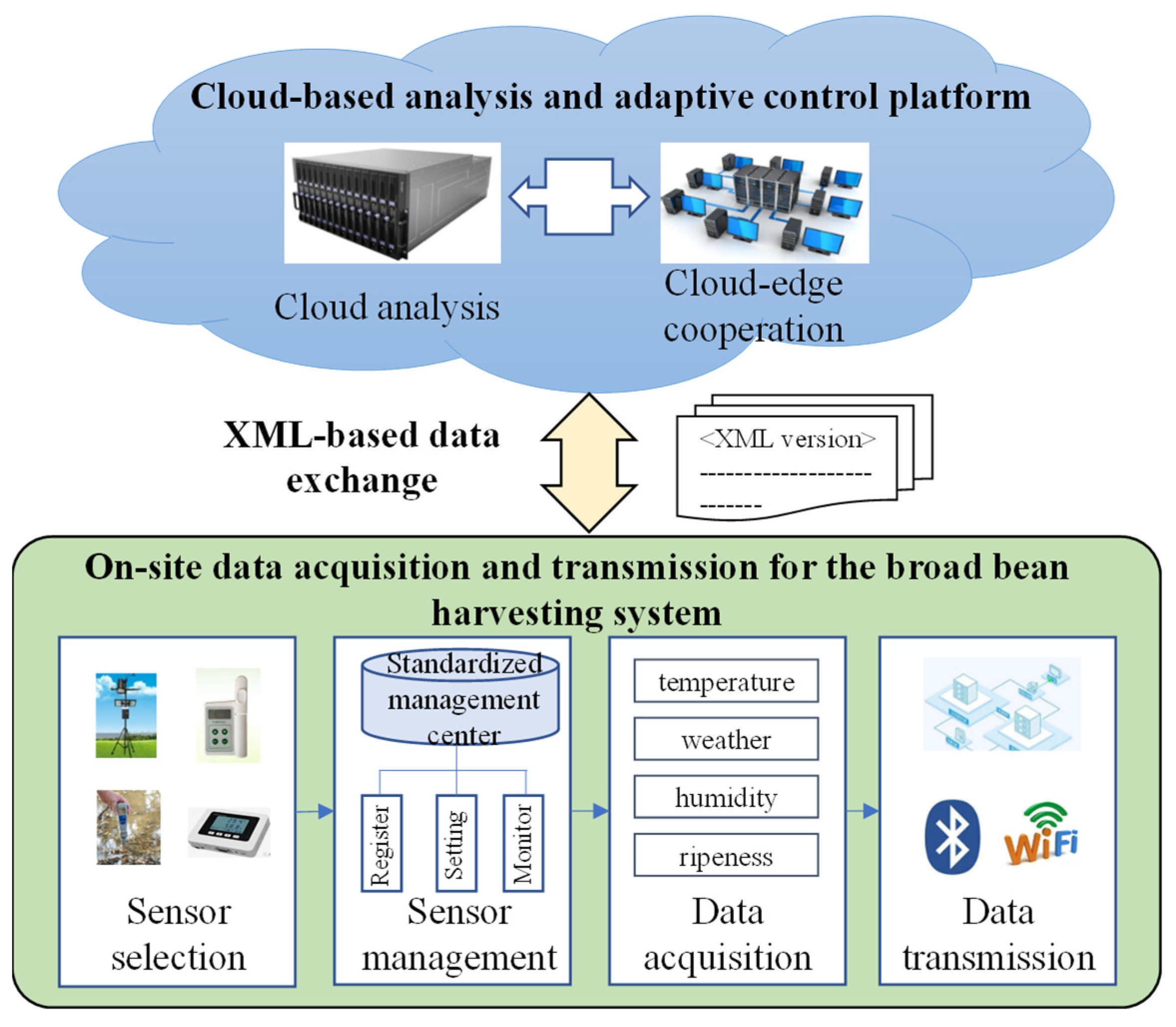

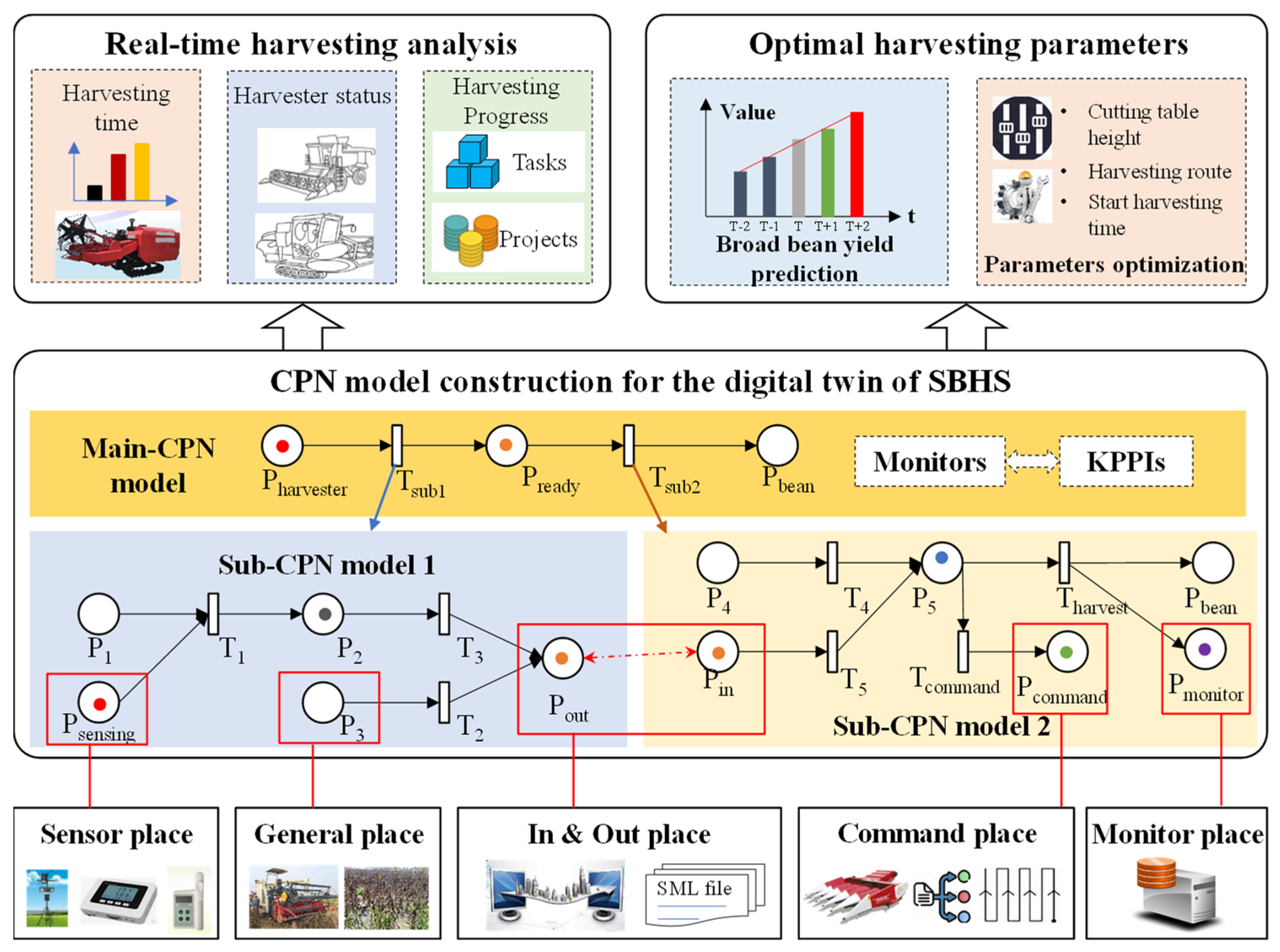
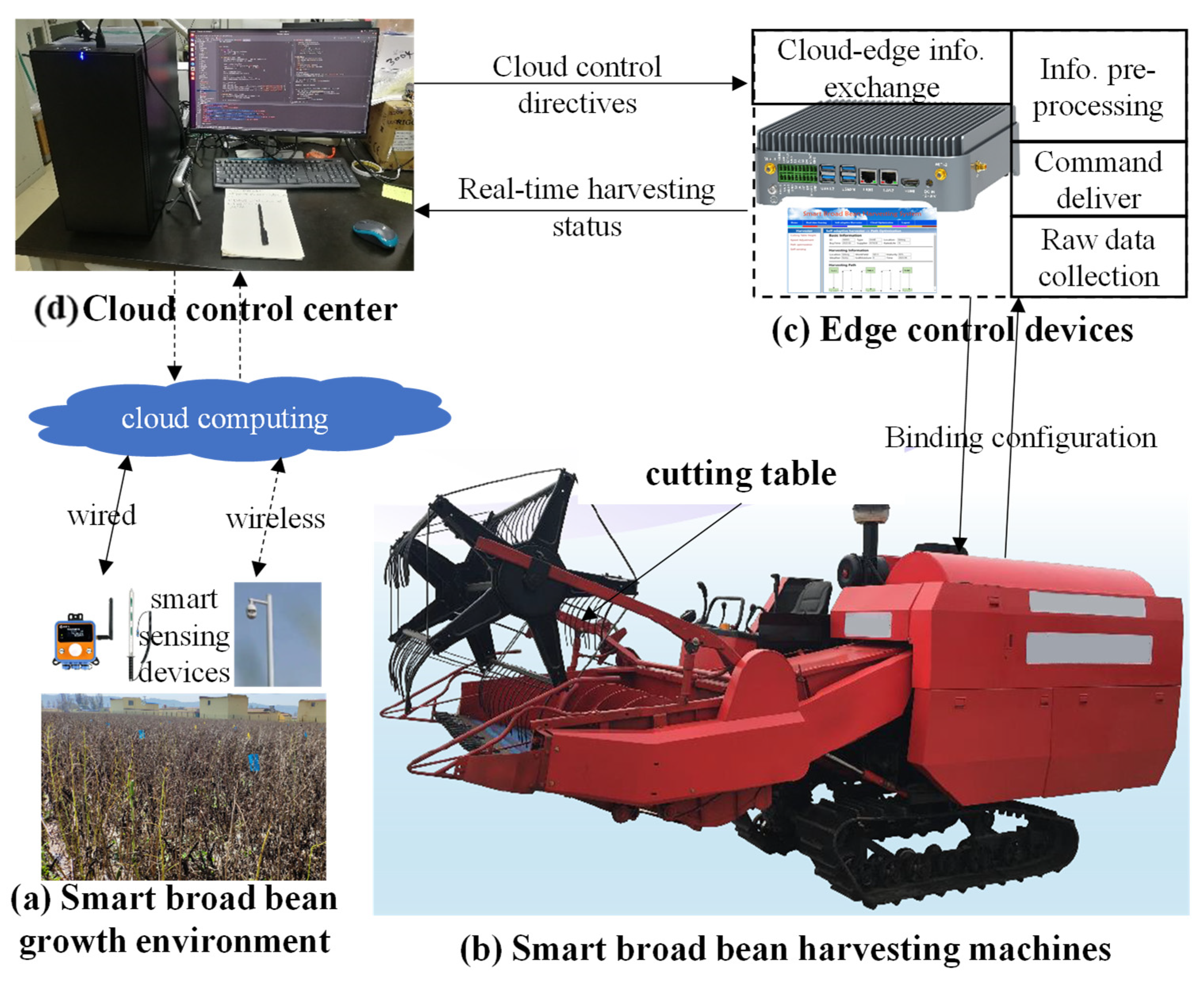
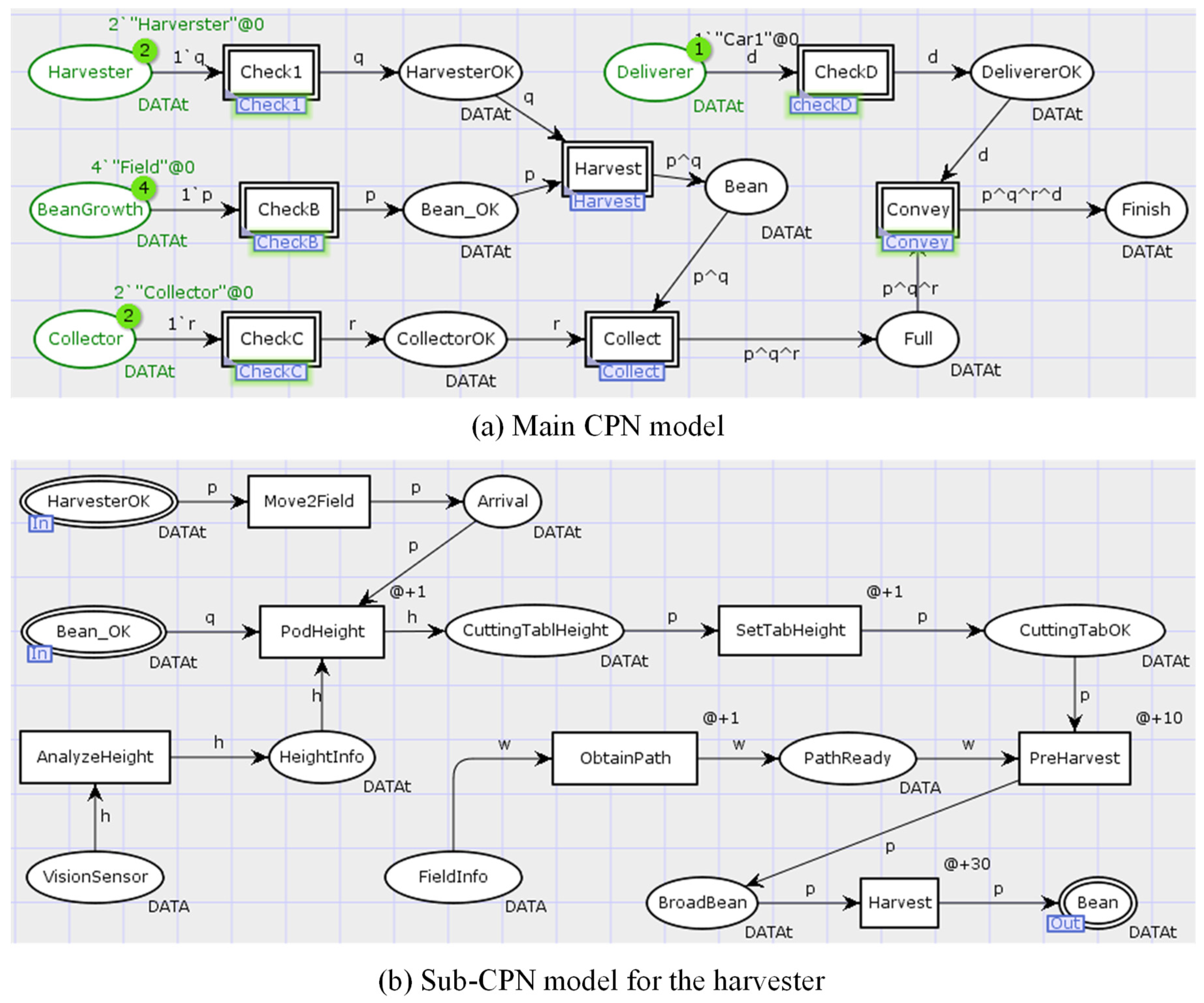

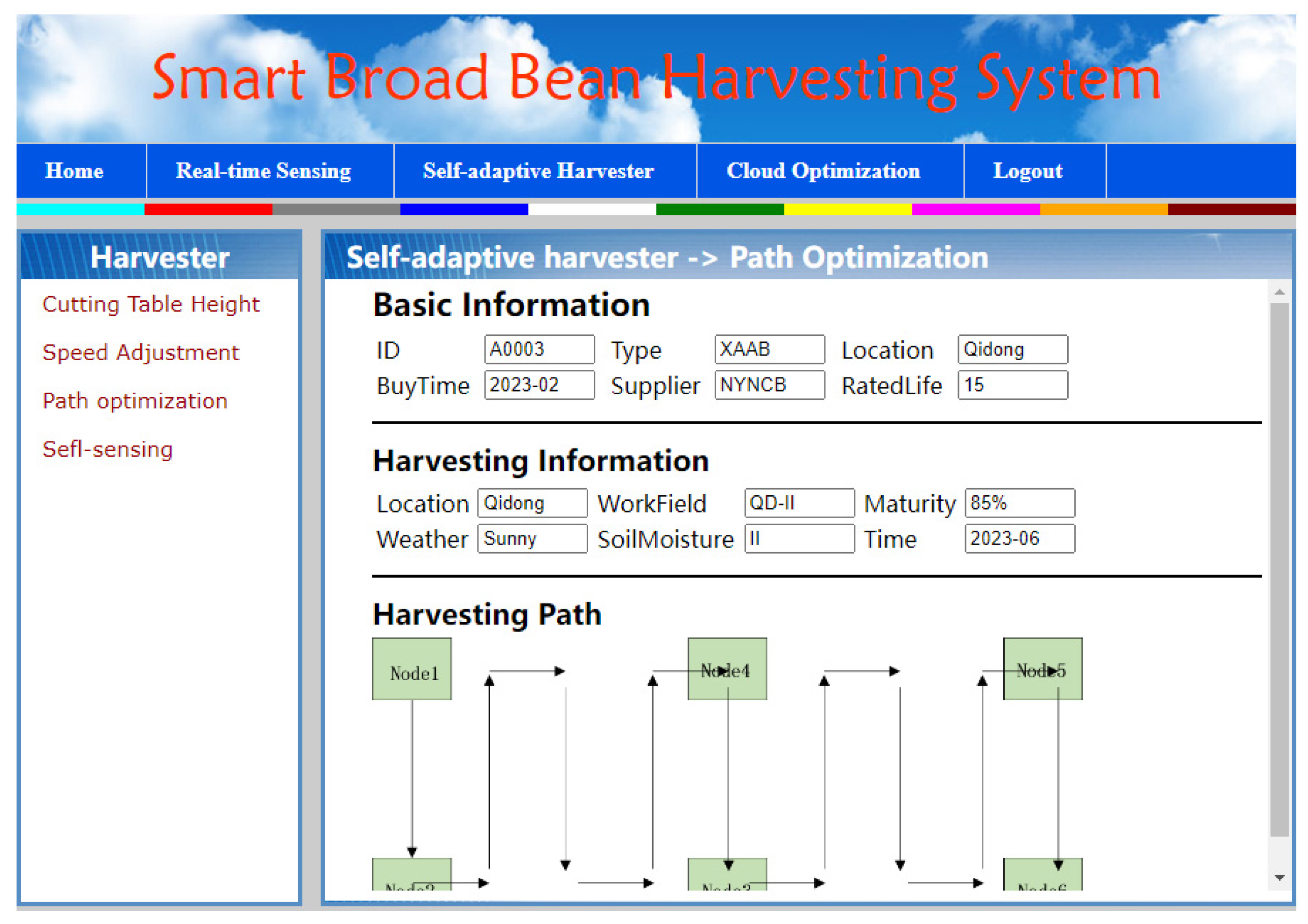

Disclaimer/Publisher’s Note: The statements, opinions and data contained in all publications are solely those of the individual author(s) and contributor(s) and not of MDPI and/or the editor(s). MDPI and/or the editor(s) disclaim responsibility for any injury to people or property resulting from any ideas, methods, instructions or products referred to in the content. |
© 2024 by the authors. Licensee MDPI, Basel, Switzerland. This article is an open access article distributed under the terms and conditions of the Creative Commons Attribution (CC BY) license (https://creativecommons.org/licenses/by/4.0/).
Share and Cite
Wang, W.; Yang, S.; Zhang, X.; Xia, X. Research on the Smart Broad Bean Harvesting System and the Self-Adaptive Control Method Based on CPS Technologies. Agronomy 2024, 14, 1405. https://doi.org/10.3390/agronomy14071405
Wang W, Yang S, Zhang X, Xia X. Research on the Smart Broad Bean Harvesting System and the Self-Adaptive Control Method Based on CPS Technologies. Agronomy. 2024; 14(7):1405. https://doi.org/10.3390/agronomy14071405
Chicago/Turabian StyleWang, Wenbo, Shaojun Yang, Xinzhou Zhang, and Xianfei Xia. 2024. "Research on the Smart Broad Bean Harvesting System and the Self-Adaptive Control Method Based on CPS Technologies" Agronomy 14, no. 7: 1405. https://doi.org/10.3390/agronomy14071405
APA StyleWang, W., Yang, S., Zhang, X., & Xia, X. (2024). Research on the Smart Broad Bean Harvesting System and the Self-Adaptive Control Method Based on CPS Technologies. Agronomy, 14(7), 1405. https://doi.org/10.3390/agronomy14071405





